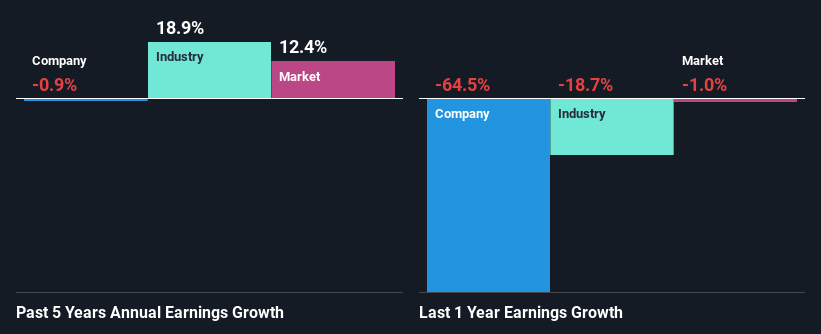Are Topps Tiles Plc's (LON:TPT) Mixed Financials The Reason For Its Gloomy Performance on The Stock Market?
It is hard to get excited after looking at Topps Tiles' (LON:TPT) recent performance, when its stock has declined 8.8% over the past three months. It is possible that the markets have ignored the company's differing financials and decided to lean-in to the negative sentiment. Fundamentals usually dictate market outcomes so it makes sense to study the company's financials. Specifically, we decided to study Topps Tiles' ROE in this article.
ROE or return on equity is a useful tool to assess how effectively a company can generate returns on the investment it received from its shareholders. In short, ROE shows the profit each dollar generates with respect to its shareholder investments.
Check out our latest analysis for Topps Tiles
How Is ROE Calculated?
The formula for return on equity is:
Return on Equity = Net Profit (from continuing operations) ÷ Shareholders' Equity
So, based on the above formula, the ROE for Topps Tiles is:
15% = UK£3.9m ÷ UK£26m (Based on the trailing twelve months to September 2023).
The 'return' is the profit over the last twelve months. Another way to think of that is that for every £1 worth of equity, the company was able to earn £0.15 in profit.
What Is The Relationship Between ROE And Earnings Growth?
Thus far, we have learned that ROE measures how efficiently a company is generating its profits. Depending on how much of these profits the company reinvests or "retains", and how effectively it does so, we are then able to assess a company’s earnings growth potential. Assuming all else is equal, companies that have both a higher return on equity and higher profit retention are usually the ones that have a higher growth rate when compared to companies that don't have the same features.
Topps Tiles' Earnings Growth And 15% ROE
To begin with, Topps Tiles seems to have a respectable ROE. Even when compared to the industry average of 15% the company's ROE looks quite decent. However, we are curious as to how Topps Tiles' decent returns still resulted in flat growth for Topps Tiles in the past five years. We reckon that there could be some other factors at play here that's limiting the company's growth. These include low earnings retention or poor allocation of capital.
Next, on comparing with the industry net income growth, we found that the industry grew its earnings by 19% over the last few years.
Earnings growth is a huge factor in stock valuation. The investor should try to establish if the expected growth or decline in earnings, whichever the case may be, is priced in. This then helps them determine if the stock is placed for a bright or bleak future. Is Topps Tiles fairly valued compared to other companies? These 3 valuation measures might help you decide.
Is Topps Tiles Using Its Retained Earnings Effectively?
Topps Tiles has a three-year median payout ratio as high as 101% meaning that the company is paying a dividend which is beyond its means. The absence of growth in Topps Tiles' earnings therefore, doesn't come as a surprise. Its usually very hard to sustain dividend payments that are higher than reported profits. This is indicative of risk. To know the 2 risks we have identified for Topps Tiles visit our risks dashboard for free.
Additionally, Topps Tiles has paid dividends over a period of at least ten years, which means that the company's management is determined to pay dividends even if it means little to no earnings growth. Upon studying the latest analysts' consensus data, we found that the company is expected to keep paying out approximately 83% of its profits over the next three years.
Summary
In total, we're a bit ambivalent about Topps Tiles' performance. In spite of the high ROE, the company has failed to see growth in its earnings due to it paying out most of its profits as dividend, with almost nothing left to invest into its own business. With that said, we studied the latest analyst forecasts and found that while the company has shrunk its earnings in the past, analysts expect its earnings to grow in the future. To know more about the latest analysts predictions for the company, check out this visualization of analyst forecasts for the company.
Have feedback on this article? Concerned about the content? Get in touch with us directly. Alternatively, email editorial-team (at) simplywallst.com.
This article by Simply Wall St is general in nature. We provide commentary based on historical data and analyst forecasts only using an unbiased methodology and our articles are not intended to be financial advice. It does not constitute a recommendation to buy or sell any stock, and does not take account of your objectives, or your financial situation. We aim to bring you long-term focused analysis driven by fundamental data. Note that our analysis may not factor in the latest price-sensitive company announcements or qualitative material. Simply Wall St has no position in any stocks mentioned.

 Yahoo Finance
Yahoo Finance 
